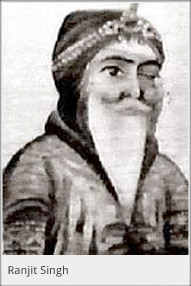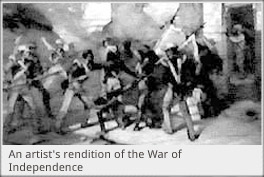By 1845, the British Empire had expanded from Bengal to Sindh, and all that remained free was Punjab. The Sikhs were ruling over Punjab and after the Second Sikh War in 1848, the British gained control over the Indus. The Koh-i-Noor diamond that Ranjit Singh had worn in his headdress now became a part of the crown jewels at Westminster.
 The War of Independence broke out in January and March 1857. The British army had recruited local Indians in their forces. These soldiers were issued cartridges greased with fat from tabooed animals. The soldiers refused to use these cartridges. In 1857, starting with an uprising in Meerut, soldiers in the British Army in Bengal launched a full-scale mutiny against the British. This mutiny spread swiftly across the Sub-continent. Initially, the Indian soldiers were able to push back the British forces. The British army was driven out of Delhi and the Indian soldiers took control of the city. Bahadur Shah Zafar, the last Mughal King, was compelled to lead the freedom fighters. In Bahadur Shah Zafar, the rebels found a symbol of freedom, but a mere symbol was all he was. Wanting to spend his days writing poetry, the man was in no way even a remnant of the glory of his forefathers. He proclaimed himself the Emperor of the whole of India. The civilians, citizens and other dignitaries took oath of allegiance to the Emperor. The Emperor issued his own coin and appointed his sons to key posts.
The War of Independence broke out in January and March 1857. The British army had recruited local Indians in their forces. These soldiers were issued cartridges greased with fat from tabooed animals. The soldiers refused to use these cartridges. In 1857, starting with an uprising in Meerut, soldiers in the British Army in Bengal launched a full-scale mutiny against the British. This mutiny spread swiftly across the Sub-continent. Initially, the Indian soldiers were able to push back the British forces. The British army was driven out of Delhi and the Indian soldiers took control of the city. Bahadur Shah Zafar, the last Mughal King, was compelled to lead the freedom fighters. In Bahadur Shah Zafar, the rebels found a symbol of freedom, but a mere symbol was all he was. Wanting to spend his days writing poetry, the man was in no way even a remnant of the glory of his forefathers. He proclaimed himself the Emperor of the whole of India. The civilians, citizens and other dignitaries took oath of allegiance to the Emperor. The Emperor issued his own coin and appointed his sons to key posts.
The initial success of the freedom fighters gave a boost to the War of Independence. The Indian army captured the important towns of Haryana, Bihar and Mahdya Pardesh. However, the British forces at Meerut and Ambala put up a resolute resistance to the royal army and held them back for several months. The British proved to be a formidable foe with their superior weapons and better strategy. The freedom fighters badly lacked in adequate resources and their planning proved to be extremely brittle. The royal forces were finally defeated. The British army entered Delhi and the Mughal emperor Bahadur Shah Zafar went into hiding.
The British quickly regained control of Delhi. They ransacked and destroyed the city. They took revenge in the most gruesome manner by killing innocent people indiscriminately. A wide scale massacre of the inhabitants of Delhi was carried out to avenge the killings of the British soldiers. The Mughal emperor was captured from his sanctuary, the tomb of Emperor Humayun. The emperor’s sons were slaughtered in cold blood. Their bodies were beheaded and their heads were presented to the aging emperor in prison. Bahadur Shah was imprisoned in Rangoon, Myanmar, where he breathed his last.
 After the War of Independence in 1857, the British government assumed sovereignty over the lands of the British East India Company. The British control over the Sub-continent grew in the next 50 years and culminated in the British Raj. Queen Victoria’s Indian realm continued to expand, until Hunza, the remote kingdom bordering China, fell into British hands in 1891, bringing the expansion to its zenith.
After the War of Independence in 1857, the British government assumed sovereignty over the lands of the British East India Company. The British control over the Sub-continent grew in the next 50 years and culminated in the British Raj. Queen Victoria’s Indian realm continued to expand, until Hunza, the remote kingdom bordering China, fell into British hands in 1891, bringing the expansion to its zenith.
The British delineated the frontier separating British India from Afghanistan in 1893. The resulting Durand Line cut straight through the tribal area of the Pathans. The British left the tribal areas to govern themselves under the supervision of British political agents.
The British thus became masters of India, where for nearly 800 years Muslims had ruled. However, their attitude towards the Muslims was that of antipathy. According to Hunter, a prominent historian, “The Muslims of India are, and have been for many years, a source of chronic danger to the British power in India”. The British attributed the war of 1857 to the Muslims alone. As a result, property belonging to Muslims was confiscated and they were denied employment opportunities everywhere in the army, revenue department, and judiciary.
The British administrators deliberately followed a discriminatory policy against the Muslims, even in filling minor jobs. Advertisements inviting applications for government jobs specifically mentioned that Muslims would not be appointed. Hunter admits that the exclusion of the Muslims was so complete that in the government offices of Calcutta they could not accept a post higher than that of a porter, messenger, filler of inkpots and mender of pens.
By a series of revenue and financial measures, the British smashed the political and social position of the Muslims. In the province of Bombay, the government appointed “Inam Commission” to inquire into the land grants of the Muslim times. The Commission took away 20,000 estates from the Muslims and thus ruined many families and institutions of the community.
The Company’s commercial policy eliminated the Muslims from internal and foreign trade. When the Europeans came to the Sub-continent, the Muslim merchants lost much of their commerce with foreign countries. But they maintained their hold on internal trade and their commercial activities extended to the Persian Gulf and the coastal territories of the Arabian Sea. During the Company’s rule, the Muslim traders were pushed out of this area as well by the competition of the Company’s traders who enjoyed many special concessions.
The newly introduced English system of education had many drawbacks for the Muslims, mainly because it made no provisions for religious education. As a result, they stayed away from it. Thus, within a few years of loss of political power, the Muslims lost all avenues of employment, were dispossessed of their estates and deprived of the benefits of education. A highly cultured community turned into a backward and poor people. In their place British-educated Hindus began to occupy positions in governments offices formerly held by the Muslims.
This article was last updated on Sunday, June 01, 2003






